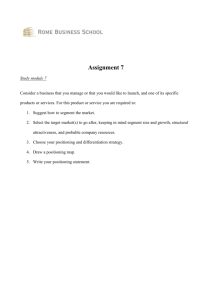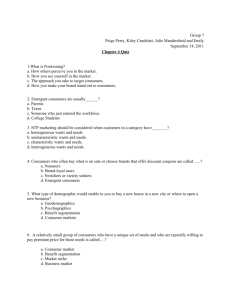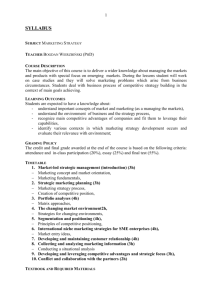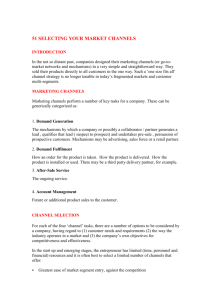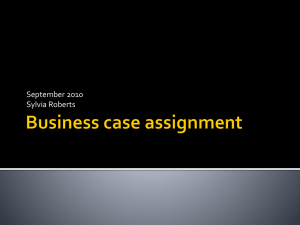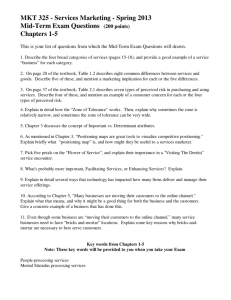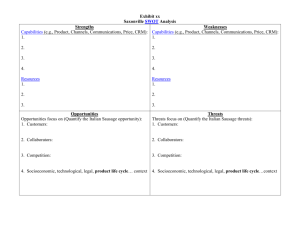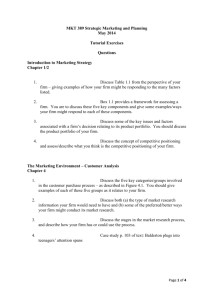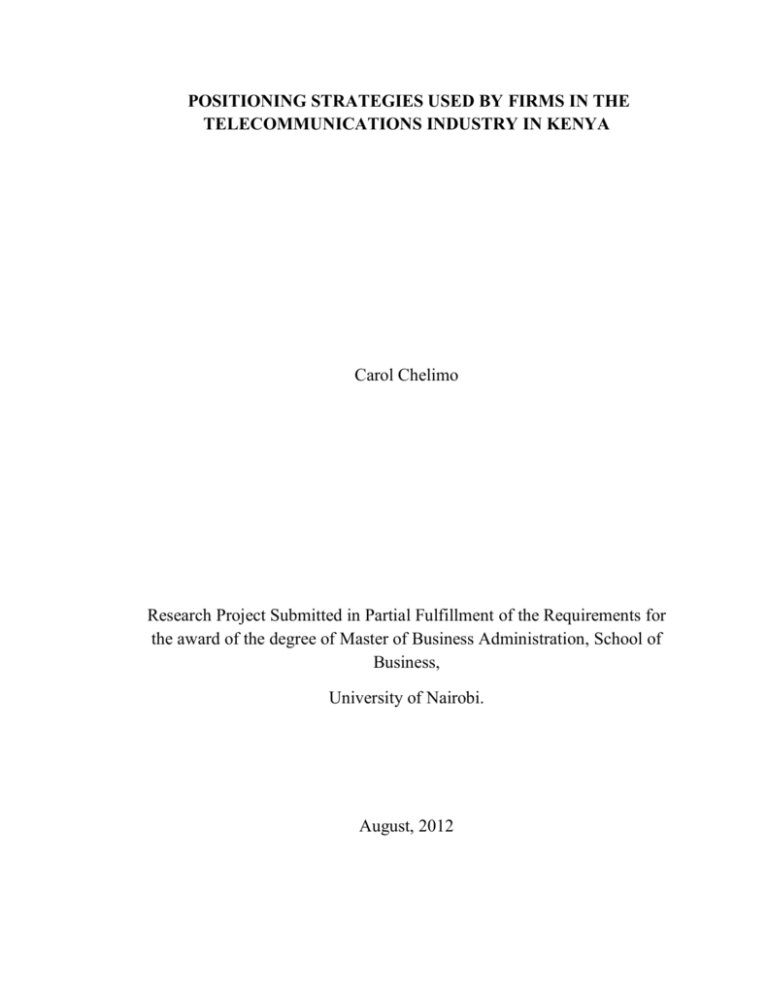
POSITIONING STRATEGIES USED BY FIRMS IN THE
TELECOMMUNICATIONS INDUSTRY IN KENYA
Carol Chelimo
Research Project Submitted in Partial Fulfillment of the Requirements for
the award of the degree of Master of Business Administration, School of
Business,
University of Nairobi.
August, 2012
DECLARATION
This research project is my original work and has not been presented for examination to
any other university.
Signed__________________________
Date_________________________________
CAROL CHELIMO
D61/62988/2010
This research project has been submitted for examination with my approval as the
university supervisor
Signed___________________________
Date ________________________
PROF. PETER K’OBONYO
DEPARTMENT OF BUSINESS ADMINISTRATION,
SCHOOL OF BUSINESS,
UNIVERSITY OF NAIROBI
ii
ACKNOWLEDGEMENTS
My special thanks go to my supervisor, Professor Peter K‟Obonyo, for his invaluable and
insightful contributions that have enriched the results of this study. His uncompromising
stance on the quality and attention to detail served to enrich the quality, scope and
contents of the study.
Profound thanks and appreciation go to all lecturers of the School of Business, University
of Nairobi who were involved in the noble task of imparting knowledge; I sincerely thank
each one of you.
My acknowledgement also go to the staff of Airtel Kenya, Safaricom Limited, Orange
Telkom Orange and Essar Telkom Kenya who contributed immensely to this work
through their logistical support.
To God almighty, thank you very much for making this possible.
iii
DEDICATION
I dedicate this work to all my family members who instilled in me the importance of
education. May this be an inspiration to you all and to generations to come to strive for
even greater heights.
iv
TABLE OF CONTENTS
DECLARATION ......................................................................................................................... ii
ACKNOWLEDGEMENTS ........................................................................................................ iii
DEDICATION ............................................................................................................................ iv
CHAPTER ONE: INTRODUCTION......................................................................................... 1
1.1
Background of the study ................................................................................................ 1
1.1.1
The concept of strategy .......................................................................................... 1
1.1.2
Positioning strategy ................................................................................................ 2
1.1.3
Telecommunication Industry in Kenya ................................................................... 3
1.2
Research Problem ......................................................................................................... 5
1.3
Research Objective ........................................................................................................ 7
1.4
Value of the Study .......................................................................................................... 7
CHAPTER TWO: LITERATURE REVIEW............................................................................ 8
2.1
Introduction .................................................................................................................. 8
2.2.
The concept of Strategy ................................................................................................. 8
2.3.
Concept of positioning strategy ................................................................................... 11
2.4.
The Concept of competition ......................................................................................... 14
CHAPTER THREE: RESEARCH METHODOLOGY ......................................................... 16
3.1
Introduction ................................................................................................................. 16
3.2
Research Design ........................................................................................................... 16
3.3
Target Population ......................................................................................................... 16
3.4
Data Collection ............................................................................................................. 17
3.4
Data Analysis ................................................................................................................ 17
CHAPTER FOUR: DATA ANALYSIS, INTERPRETATION AND DISCUSSION. .......... 18
4.1
Introduction ................................................................................................................. 18
4.2 Response Rate .................................................................................................................... 18
4.2 Job Position in the Company .............................................................................................. 18
v
4.3 Job Experience ................................................................................................................... 19
4.4 Positioning Strategies based on product attributes ........................................................... 19
4.5 Perceived Influence of Positioning Strategies on the firms competitiveness ..................... 20
4.6 Perceptions of the link between positioning strategies and Brand choice ......................... 21
4.7 Perceived use of positioning strategies .............................................................................. 22
CHAPTER FIVE: SUMMARY, CONCLUSION AND RECOMMENDATIONS ............... 24
5.1 Introduction ....................................................................................................................... 24
5.2 Summary of the findings and Discussion ............................................................................ 24
5.3 Recommendations ............................................................................................................. 25
5.3.1 Recommendation for further research ......................................................................... 26
5.4 Limitations of the Study ..................................................................................................... 26
References ................................................................................................................................... 27
APPENDIX ................................................................................................................................. 31
vi
ABBREVIATIONS AND ACRONYMS
CBK
Central Bank of Kenya
CCK
Communications Commission of Kenya
GoK
Government of Kenya
GPRS
General Packet radio Services.
GSM
Global Systems for Mobile
KP&TC
Kenya Posts and Telecommunications Corporation
MBO
Management by Objectives
PCK
Postal Corporation of Kenya
SBU
Strategic Business Unit
SCA
Strategic Competitive advantage
SMS
Short Message Service
SP
Strategic Positioning.
SPSS
Statistical Package for Social Science
SWOT
Strengths, weaknesses, Opportunities and Threats
TKL
Telkom Kenya Limited
VOIP
Voice over Internet Protocol
vii
LIST OF FIGURES
Figure1: Generic Strategies…………………………………………………………… 10
viii
LIST OF TABLES
Table 4.1: Respondents age Group………………………………………………………18
Table 4.2: Job Position in the Company…………………………………………………19
Table 4.3: Job Experience in the Company……………………………………………...20
Table 4.4: Positioning strategies based on product attributes………………..………….20
Table 4.5: Perceived influence of positioning strategies on the firms
competitiveness…………………………………………………………………….….…21
Table 4.6: Perceptions of the Link between positioning strategies and brand choice ......22
Table 4.7: Perceived use of Positioning Strategies
ix
………………………………..….23
ABSTRACT
The success and sustainability of any organization in a competitive environment is
determined by its choice of strategy.
However most strategies are replicated by
competitors and thus a company must position itself in the minds of the consumer in
order to remain competitive. This study was an attempt to determine the positioning
strategies applied used by Telecommunication firms in Kenya. From Introduction of
Telecommunication services in the colonial times up to 1977, the services in Kenya were
managed as part of regional network with neighboring East African community .It
collapsed as a result of Establishment of Kenya Posts and Telecommunications
Corporation (KP&TC) The challenge at that time was to transform the existing policy
Structure from one designed for a monopoly to a policy managing a liberalized
telecommunication
Market.
In
1998/1999,
the
government
Launched
the
Telecommunications sector reform and introduced competition in certain market
segments, while at the same time Disbanding KP&TC (CCK, 2001). There are four
major players in the Telecommunications industry in Kenya. These are: Safaricom
Limited, Airtel Kenya, Telkom Kenya which operates under the Orange Brand and Essar
Telecom Kenya which operates under the Brand name Yu Mobile.
A census study method was used since the number of firms was small and it is a sound
basis for gathering insight information from the firms in the Kenyan Telecommunication
industry on the positioning strategies they use. The data for the study was primary data
collected using semi-structured questionnaires. These questionnaires were administered
to persons in charge of Strategic planning function, and in their absence, to persons in
charge of the marketing function. Data was analyzed using descriptive statistics such as
mean scores, frequency distributions and percentages.
The research objective of this study was to determine the positioning strategies used by
firms in the Telecommunication industry in Kenya in the competitive environment. From
the research, it was established that most telecommunication firms are preferred by
customers because of their competitive prices, product characteristics, technological
advancement and superior product characteristics as this affects positioning to a greater
extent.
x
CHAPTER ONE
INTRODUCTION
1.1
Background of the study
With increased competition in various industries including the service industry, operators
have turned to bundled and converged services to improve their market positions. (De
melo, 2000) The ability of operators and their partners to rapidly seize new opportunities
anticipate customer demands and be able to quickly modify strategies and position
themselves in the consumers mind will determine the ongoing success of industries in the
Kenyan Market (Economic survey, 2010.)
Companies in the Telecommunication industry in Kenya have come up with different
approaches in developing positioning strategies even though all of them have the
common objective of projecting a favorable image in the minds of the consumers.
Position strategies can be conceived and developed in a variety of ways from object
attributes competition Application, Flexibility, Reliability Dependability, Value for
money or the characteristics of the products class. (ICT MTEF Sector report, 2008). New
entrants have entered into local communications market from wireless cell phones and
networks for wireless internet access to long distance carriers, VOIP internet telephone
service providers and cable companies. Today Company‟s strategic choice has become
important to create customer value and keep market shares. To achieve this, it involves
positioning strategic decisions in respect to competition. (Business Report, January 5,
2012)
1.1.1 The concept of strategy
The strategic Management process is essentially concerned with the decisions the
organizations make about their future direction and the development and the
implementation strategies which will enhance the Competitiveness of the organizations.
1
Strategy has many different interpretations and dimensions. Some of the definitions of
strategy include; A Means of establishing the organizational purpose, in terms of long
term objectives, action programmes, and resource allocation priorities. Chandler (1962);
The basic characteristics of the match an organization achieves with its environment‟
Hofer and Schendel (1978); The search for a favorable competitive position in an
industry, the fundamental arena in which competition occurs. Porter (1980); The
direction and scope of an organization over the long term which achieves advantage in
the Changing environment through its configuration of resources and competences with
the aim of fulfilling stakeholder expectations. Johnson et al (2008).
Strategy is therefore concerned with long term direction, meeting challenges from the
firm‟s business environment such as competitors and changing g needs of customers and
using the organizational internal resources and competencies effectively and building on
its strengths to meet environmental challenges. Whatever the interpretation is put on
strategy, the strategic actions of an organization will have a widespread and long term
consequences for the position of the organization in the market place, its relationship with
different stakeholders and overall performance.
1.1.2 Positioning strategy
Positioning is the act of designing the company‟s offering and image to occupy a
distinctive place in the mind of the target market. The goal is to locate the brand in the
minds of consumers to maximize the potential benefit of the firm. (Kotler & Keller,
2006). When a firm or provider establishes and maintains a distinctive place for itself and
its offerings in the market, it is said to be successfully positioned. (Al Ries and Trout,
1972) Positioning must establish a position for the product firm in the customers mind
should be distinctive providing one simple consistent message and must set the
product/firm apart from competitors. It should be noted that a firm cannot be all things to
all people and therefore must focus. To be successful in the long term, the operations of a
firm must be completely different from those traditional business counterparts. That is the
strategic positioning decision of a Telecommunication firm must establish its own unique
2
competitive advantages over its traditional business competitors and sustain its on regular
basis (Klinkerman, 2000; 2001).
Positioning is one of marketing's most critical tasks. For some marketers (e.g., Ries and
Trout 1981), positioning is strictly a communications issue. The product or service is a
given and the objective is to manipulate consumer perceptions of reality. As Lovelock
(1984) rightly points out, however, positioning is more than just advertising and
promotion. Positioning strategies can be conceived and developed in a variety of ways. It
can be derived from object attributes, competition, application, types of consumers
involved or the characteristics of the product .All these attributes represent a different
approach in developing positioning strategies, even though all of them have the common
objective of projecting a favorable image in the minds of the consumer.
As processes, services have many intriguing characteristics. Judd (1964), Rathmell
(1974), Shostack (1977), Bateson (1977), and Sasser, Olsen, and Wyckoff (1978) were
among the first to ponder the implications of service intangibility, service perishability,
production/consumption simultaneity, and consumer participation in service processes.
They found that traditional marketing, with its goods bound approaches, was not helpful
in process design, process modification, or process control. If processes are the service
equivalent of a product's "raw materials," can processes be designed, managed, and
changed for positioning purposes the way physical goods are?
1.1.3 Telecommunication Industry in Kenya
From Introduction of Telecommunication services in the colonial times up to 1977, the
services in Kenya were managed as part of regional network with neighboring East
African community .It collapsed
as a result of Establishment of Kenya Posts and
Telecommunications Corporation (KP&TC) (Africa Business Pages, 2003). A
telecommunications policy statement was issued in 1977 that set out the Government
vision on telecommunications development to the year 2015. The challenge at that time
was to transform the existing policy Structure from one designed for a monopoly to a
policy managing a liberalized telecommunication Market. In 1998/1999, the government
3
Launched the Telecommunications sector reform and introduced competition in certain
market segments, while at the same time Disbanding KP&TC (CCK, 2001).
There are four major players in the Telecommunications industry in Kenya. These are:
Safaricom Limited, Airtel Kenya, Telkom Kenya which operates under the Orange Brand
and Essar Telecom Kenya which operates under the Brand name Yu Mobile. Safaricom,
Ltd is a leading mobile network operator in Kenya. It was formed in 1997 and is engaged
in the provision of mobile phone services, fixed line wireless telecommunication, Internet
and data services. It provides such products and services, as general packet radio services
(GPRS), third generation (3G), enhanced data GSM environment (EDGE) and mobile
money transfer solution M-Pesa. Safaricom PrePay service includes international dialing,
voice mail and prepays roaming. Messaging includes ways of communication, such as
short message service (SMS), e-mail and multimedia (GoK, 2010). As of January 2010,
Safaricom boasts a subscriber base of approximately 12 million, most of who are in the
major cities - Nairobi, Mombasa, Kisumu and Nakuru (www.economist.com).
Airtel was launched in Kenya in 2000 as Kencell and rebranded to Zain in 2008 and
finally Airtel in 2010. Airtel Kenya offer a host of value added services including: Airtel
Money, Prepaid and Postpaid plans, One Network, Blackberry devices and services,
International roaming, Local and international text messaging,24-hour customer care
centre, Internet access, Directory enquires, SMS information services, Mobile Top up
andMe2U.Airtel in Kenya is a great success story. Their customer base is growing
tremendously so have their coverage and our service quality. (CBK, 2011)
Telkom Kenya was established as a telecommunications operator under the Companies
Act in April 1999. It was previously a part of the Kenya Posts and Telecommunications
Corporation (KPTC) which was the sole provider of both postal and telecommunication
services. In 1999 KPTC was split into the Communication Commission of Kenya (CCK),
the Postal Corporation of Kenya (PCK) and Telkom Kenya. Telkom Kenya provide
integrated communications solutions in Kenya with the widest range of voice and data
services as well as network facilities for residential and business customers. The
4
company held the monopoly on land-line operations in Kenya, but its business suffered as
Kenyans swapped fixed-line phones for mobiles from other providers. (CCK press
release, 08/4, 2002). During the privatization process of 2006, Telkom Kenya had
315,000 subscribers out of a population of 35 million, compared to 7 million people
subscribed to the mobile phone services. Telkom Kenya Limited tilted towards
bankruptcy due to increased competitive pressure from private mobile telephony players.
Unbundling of its 60 percent share in Safaricom funded the restructuring of Telkom
Kenya Limited‟s balance sheet and it was privatized free of major government liabilities,
including government debts and pension deficits. France Telecom acquired 51 percent
stake which later saw the launch of the Orange Brand in Kenya. (www.telkom
Kenya.co.ke). Essar Telecom Kenya is Kenya‟s fourth mobile cellular network under the
brand “yuMobile” launched in December 2008. Currently, the network has a subscriber
base of over 2.3M subscribers and offers subscribers competitive call rates
(www.yu.com). Their tariff offer is not only simple but the lowest in the market, ensuring
that communication is also affordable to the people at the bottom of the pyramid. With a
focus on being the best sales & distribution company in Kenya, they have continued to
work diligently towards claiming a place in the mobile telephony market by successfully
unveiling exciting packages targeting various market segments by providing services
such as money transfer (Yu cash), international dialing, caller ring back tones and more
in the pipeline. (www.yu.co.ke)
1.2
Research Problem
An organization‟s strategy consists of the moves and approaches devised by management
to produce successful organization performance. A strategy is thus a management game
plan for the business (Thompson et al, 2006). The essence of formulating a competitive
strategy is to relate a company to its environment (Porter, 1998). Formulating competitive
brand strategy is an important problem for marketing managers but how these strategies
are positioned is more important because strategies can always be replicated by
competitors. When a firm or provider establishes and maintains a distinctive place for
itself and its offerings in the market, it is said to be successfully positioned. In the
5
increasingly competitive service sector, effective positioning is one of marketing's most
critical tasks.
Buyer perceptions of brand positions and competitive reaction are
important determinants of optimal competitive brand strategy (Hauser, 1988). Success of
a company will depend on its ability to quickly modify strategies and position themselves
in the minds of the customer
Competition improves the performance of any industry at the same time ensuring quality
services to customers; however since the introduction of competition within the
telecommunication sector service, providers are struggling to survive because there has
been throat cut competition that has necessitated firms to critically choose its competitive
response strategies that are effective. Telecommunications industry is a changing industry
and is expanding rapidly. These changes have been driven by customer needs, technology
changes and emergence of new business models and therefore a much more complex,
Diverse and competitive telecommunications environment. In the past few years, new
service providers have entered the local communications market with products such as
wireless cell phones and networks for wireless internet access to long distance carriers,
VOIP internet telephone service, money transfer services, discounts on tariffs, cheaper
handsets and lap tops. Today Company‟s Positioning strategic choice has become
important to create customer value and keep market shares. To achieve this, it involves
positioning strategies in respect to competition
Past studies that have been carried out on similar topics include: Kandie (2001) carried
out a study on the strategic responses by TKL in a competitive environment. His findings
were that in 2001, TKL was faced with financial, technological, overstaffing,
bureaucratic processes and procedures, attitude and culture change, pension liability,
planning, strategy challenges and Competition from new entrants in the Market. Kandie‟s
approach focused mainly on the environment, planning & strategy for TKL. He did not
examine how to position these strategies in the customers Mind in order to remain
relevant in the competitive environment. Omondi (2003) did a case study on Savings &
Loans (Kenya) Ltd on responses of mortgage companies in Kenya to threats of new
entrants. Omondi found that Savings & Loans responded to the competitive situation by
6
restructuring, marketing, adopting ICT and cultural changes. Mutugi (2006), studied
responses of micro finance institutions in Kenya to the turbulent business environment .
Her study found that environmental forces affect the types of products and services
developed, positioning and market strategies. Previous studies focused mainly on the
practice of strategic management mainly strategy formulation, implementation and
evaluation processes. The area of concern is how these strategies positioned in the
industry to catch the attention of the consumer. From these studies, there is no clear
assessment on positioning strategies in the Telecommunication industry. This creates a
knowledge gap and therefore this study is aimed at addressing this gap on strategies used
by companies in the Kenyan Telecommunication industry to position themselves in a way
of appearing superior in the minds of consumers compared to their competitors. The
following question arises from the above: What strategies do organizations in a
competitive environment use to position themselves?
1.3
Research Objective
Objective of this study was to determine the Positioning strategies used by companies in
the Kenyan Telecommunication Industry.
1.4
Value of the Study
The study was aimed at benefiting: Companies not only in the Telecommunication
industry to identify not only how to come up with appropriate strategies to compete but
also how to position their products or services in the minds of the consumers in order to
remain competitive; Other Researchers who may have an interest in researching deeper
into this area as it is a grey area with no well documented literature and further provide a
forum of reasons why it is important to anticipate customer demands and be able to
quickly modify strategies and Position themselves in Business.
7
CHAPTER TWO
LITERATURE REVIEW
2.1
Introduction
This chapter presents existing literature as regards to positioning strategies. The concern
is how does a business achieve and maintain a superior competitive position in a market.
This question is at the heart of the strategy development process and largely defines the
field of strategic management. Simply superior competitive strategic position means
higher returns and profitability. It is relevant to consumers‟ willingness-to–pay.
Sustainable competitive advantage (SCA) is an important concept in strategic
management literature. It is often observed that companies position themselves based on
their strength, or the advantages they posses compared to their competitors. Therefore,
SCA is playing a major role in company‟s strategic positioning against its competitors.
2.2.
The concept of Strategy
Strategy occurs at different levels of organization: The Corporate level, the Business
level and the Functional level. (Andrews, 1980). Corporate level strategy occupies the
highest level of strategic decision-making and covers actions dealing with the objective
of the firm, acquisition and allocation of resources and coordination of strategies of
various SBUs for optimal performance. It defines the Business in which the company will
compete, preferably in a way that focuses resources to convert distinctive competence in
to competitive advantage.
Business-level strategy is – applicable in those organizations, which have different
businesses-and each business is treated as strategic business unit (SBU). The fundamental
concept in SBU is to identify the discrete independent product/market segments served
by an organization (Andrews, 1980). Business strategy is the determination of how a
company will compete in a given Business and position itself among its competitors.
Functional level strategy, as is suggested by the title, relates to a single functional
8
operation and the activities involved therein. It deals with relatively restricted plan
providing objectives for specific function, allocation of resources among different
operations within that functional area and co-ordination between them for optimal
contribution to the achievement of the SBU and corporate-level objectives (Andrews,
1980).
Strategic management as a discipline originated in the 1950s and 1960s. Drucker (1954)
came up with the idea of what Business an organization wanted to be in. Drucker‟s
contributions to strategic management were many but two most important are the
importance of objectives to an Organization and the importance of Intellectual capital.
Alfred Chandler recognized the importance of coordinating the various aspects of
management under one all-encompassing strategy. Prior to this time the various functions
of management were separate with little overall coordination or strategy. Chandler (1962)
showed that a long-term coordinated strategy was necessary to give a company structure,
direction, and focus. He says it concisely, “Structure follows strategy”. The challenge in
this period was how to manage companies bettering the face of growth opportunities.
With growing business, there came the disenchantment period which was characterized
by dissatisfaction planning because there was increased environmental turbulence,
reduced Business opportunities and increased competition. Strategic planning as
developed in stable environment could not cope with the challenges of the new turbulent
environment because: it lacked orientation; too much emphasis was placed on planning,
planning and implementation had been separated and it inhibited strategic thinking.
Selznick (1957) introduced the idea of matching the organization's internal factors with
external environmental circumstances. This core idea was developed into what we now
call SWOT analysis by Learned, Andrews, and others at the Harvard Business School
General Management Group. Further, Ansoff (1965) built on Chandler's work by adding
a range of strategic concepts. He developed a strategy grid that compared market
penetration strategies, product development strategies, market development strategies and
horizontal and vertical integration and diversification strategies. He felt that management
9
could use these strategies to systematically prepare for future opportunities and
challenges.
Strategic management had to be rediscovered because it had gone out of fashion and
therefore had to be “Rethought” and “Recast”(Porter 1987). This included Linking
planning and action, including line managers on planning and implementation, placing
more emphasis on action of key issues and enhancing strategic thinking. This era
encourage managers to think strategically and come up with solutions that will match the
situation at hand. Different strategies suit different situations due to the dynamism of the
environment. No one strategy works in all situations.Porter‟s Competitive Strategy in
1980 initiated the era of generic strategies. These generic strategies represent the three
ways in which an organization could provide its customers with what they wanted at a
better price, or more effectively than others. Essentially, Porter maintained that
companies compete either on price (cost), on perceived value (differentiation), or by
focusing on a very specific customer (market segmentation). Porter‟s generic strategies
are summarized in Figure 2.
Narrow Market scope
Segmentation(Focus Strategy)
Broad Market scope
Differentiation Strategy
Cost Leadership
Uniqueness Competence
Cost leadership
Figure 1 – Generic Strategies
Source: Porter, M. E. (1980). Competitive Strategy. New York: Free Press.
The most advantageous position for the producer is one that yields the highest rating
among the target segments. Whether this is a feasible position or not depends mainly on
the company‟s specific production and marketing capabilities (Johansson & Thorelly,
1985). Hill (1988) stated that differentiation can be a means for firms to achieve an
overall low-cost position and contrary to Porter‟s statement, cost leadership and
differentiation are not necessarily inconsistent. Moreover, there are many situations in
which establishing a sustained competitive advantage requires the firm to simultaneously
pursue both low-cost and differentiation strategies because in many industries there is no
10
unique low-cost position. It is possible to differentiate a relatively homogeneous product
if the psychological characteristics of consumers are diverse (Hill, 1988).
Empirical approach was based on the identification of market segments (Treace and
Wiersema, 1993). They explained that in any sector there are three value disciplines –
operational excellence, customer intimacy, or product leadership. Operational excellence
means providing customers with reliable products or services at competitive process and
delivered with minimal difficulty or inconvenience. Customer intimacy means
segmenting and targeting markets precisely and then tailoring offerings to match exactly
the demands of those niches. And product leadership means offering customers leadingedge products and services that consistently enhance the customer‟s use or application of
the
product,
thereby
making
rivals‟
goods
obsolete
(Treacy
&Wiersema,
1993).According to Bowman (2008) “Product leadership” is a strategy of differentiation
through innovation, and “customer intimacy” is a strategy of differentiation through
bespoke service. Bowman strategies are based on the principle of achieving competitive
advantage by providing customers with what they want, or need, better or more
effectively than competitors.
2.3.
Concept of positioning strategy
When a firm or provider establishes and maintains a distinctive place for itself and its
offerings in the market, it is said to be successfully positioned. In the increasingly
competitive service sector, effective positioning is one of marketing's most critical tasks.
For some marketers (e.g., Ries and Trout 1981), positioning is strictly a communications
issue. The product or service is a given and the objective is to manipulate consumer
perceptions of reality. As Love- lock (1984) rightly points out, however, positioning is
more than just advertising and promotion. Market position can be affected by pricing,
distribution and, of course, the product itself, which is the core around which all
positioning strategies revolve. Apart from promotion, pricing, and distribution, the
product is indeed a critical, manageable factor in positioning
11
Firms are not monolithic entities of a given good or service. Jarillo (1988) wrote about
superior mode of organization, the strategic network. Jarillo stressed the importance of
complex arrays of relationships between firms established through interaction with each
other. These interactions imply investments to build the relationships, which gives
consistency to the network. Jarillo sees competition more as a matter of positioning one‟s
firm in the network than attacking the environment. If a firm is able to obtain an
arrangement whereby it “farms out” activities to the most efficient supplier, keeps for
itself that activity in which it has a comparative advantage, and lowers transaction costs
(Jarillo, 1988). Similar to Jarillo, authors Håkansson and Snehota (1995) state that
strategy development is about positioning the company in the overall business network
through the development of its relationships. It is about maneuvering for a favorable
position for the company in the network. The critical issue for management is monitoring
the changes in the network structure that affect the position and thus the capability and
capacity of the company. Changes must be assessed in terms of their likely impact on the
position of the company with respect to the wider activity pattern, resource constellation
and web of actors (Håkansson & Snehota, 1995).
There are seven market-positioning strategies which are relevant to a large number of
situation (Boyd et al. ,1998): Mono-segment positioning (positioning to a single market
segment), Multi-segment positioning (to attract consumers from different segments),
Standby positioning (is used to minimize respond time switching from multi-segment to
mono-segment positioning), Imitative positioning (position similar to existing successful
brand), Anticipatory positioning (position of a new brand in anticipation of the evolution
of the segment‟s needs), Adaptive positioning (periodical repositioning a brand to follow
the evolution of the segment‟s needs) and Defensive positioning (introducing additional
brand in a similar position for the same segment to defend itself against competitors)
(Boyd, Walker, & Larreche, 1998). Similar to imitative and adaptive positioning
strategies, Cockburn et al. (2000) talked about creation and imitation processes in
achieving competitive advantage. Firms which are positioned most unfavorably respond
12
more aggressively to environmental changes to reposition themselves and re-level the
playing field (Cockburn, Henderson, & Stern, 2000).
Positioning starts with the product, but positioning is not what you do to a product.
Positioning is what you do to the mind of the prospect. That is, you position the product
in the mind of the prospect (Ries & Trout, 2001). Positioning can be defined as an
organized system for finding a window in the mind. It is based on the concept that
communication can only take place at the right time and under the right circumstances.
Positioning “…is the act of designing the company‟s offering and image to occupy a
distinctive place in the mind of the target market. The goal is to locate the brand in the
minds of consumers to maximize the potential benefit of the firm” (Kotler & Keller,
2006, p. 310)In strategy terms competitive positioning is described as “…creating brand
superiority in the minds of customers. Fundamentally, positioning convinces consumers
of the advantages or point of difference a brand has over competitors, while at the same
time alleviating concerns about any possible disadvantages (establishing points of
parity)” (Keller, 2008, p. 38).
Even though a product‟s physical characteristics can be designed to achieve a particular
position in the market, customers may attach less importance to some of these
characteristics than what the firm expects. Many consumers do not want to be bothered
about a product‟s physical characteristics because they are not buying these physical
properties but rather the benefits they provide. A consumer can typically evaluate a
product better on the basis of what it does than what it is. Therefore perceptual
positioning analyses are critically important. Boyd et al. (1998) also separate dimensions
of attributes how consumers perceive competitive offerings: simple physically based
attributes (e.g. price, quality, power or size), complex physically based attributes (e.g.
efficiency of computer system, roominess of the car, user friendliness of service) and
essentially abstract attributes (e.g. prestige of a car).
13
2.4.
The Concept of competition
Sustainable Competitive Advantage (SCA) is an important concept in strategic
management literature and it is gaining more and more popularity among researchers.
This work will analyze, systemize and summarize existing literature about SCA. It is
often observed that companies position themselves based on their strength, or the
advantages they posses comparing to their competitors. Therefore, SCA is playing a
major role in company‟s strategic positioning against its competitors.
The fundamental principle of the resource-based view is that the basis for a competitive
advantage of a firm lies primarily in the application of the bundle of valuable resources at
the firm‟s disposal. The resource based view of the firm is based on two underlying
assertions, as developed in strategic management theory: (1) that the resources and
capabilities possessed by competing firms may differ (resource heterogeneity); and (2)
that these differences may be long lasting (resource immobility) (Mata et al, 1995). The
RBV is the most widespread theory explaining the concept of SCA. It is an introverting
approach looking for the sources of competitive advantage inside the company in its
assets and capabilities. Comparing to assets (which are tangible resource endowments),
the capabilities are more complex entities. The RBV holds that, in order to generate SCA,
a resource must provide economic value and must be presently scarce, difficult to imitate,
non-substitutable, and not readily obtainable in factor markets.
The term SCA was proposed by Porter (1985), when he discussed the basic types of
competitive strategies firms can follow (low cost, differentiation, and focus) to achieve
SCA. There is no common meaning for competitive advantage" in practice or in the
marketing strategy literature. Sometimes the term is used interchangeably with
"distinctive competence" to mean relative superiority in skills and resources (Day &
Wensley, 1988). Hoffman (2000) proposed the following definition of SCA: “A SCA is
the prolonged benefit of implementing some unique value-creating strategy not
simultaneously being implemented by any current or potential competitor, along with the
inability to duplicate the benefits of this strategy” (Hoffmann, 2000, p. 1).
14
The most widespread theory explaining sources of competitive advantage is the
“resource-based view” (RBV). Superior skills and superior resources which are also
referred to as assets and Capabilities are the main sources of competitive advantage (Day
and Wensley, 1988). Assets are the resource endowments the business has accumulated,
and capabilities are the glue that keeps these assets together and enables them to be
deployed advantageously. Ulrich and Lake (1991) contend that three traditional means of
gaining competitive advantage (financial, strategic and technological capabilities)
describe only a portion of what managers need to do. They stress organizational
capability as a critical source of competitive advantage, which is based on the premise
that organizations do not think, make decisions, or allocate resources, but people do.
They argue that people issues should be managed simultaneously with other strategies.
Firms should focus their efforts on creating a culture in organization which can drive the
success of other tools like quality training, process improvement, and benchmarking
associated with Total Quality Management (Powell, 1995). Day (1994) examines the role
of capabilities in creating a market-oriented organization. He emphasizes the importance
of market sensing capability and customer linking capability. Market sensing is ability of
the firm to learn about customers, competitors, and channel members in order to
continuously sense and act on events and trends in present and prospective markets.
Customer linking is about creating and managing close customer relationship and
therefore the products of the company are positioned better in the minds of the consumer.
15
CHAPTER THREE
RESEARCH METHODOLOGY
3.1
Introduction
This chapter highlights the Research Methodology for the Study. It includes Research
Design, Population, and Sample Design, Data collection as well as data analysis and
ethical issues.
3.2
Research Design
The research design used in this study was a survey design. This Design entails the
collection of data of more than one case and at a single point in time in order to collect a
body of qualitative or quantifiable data in connection with several variables which are
then examined to detect the patterns of association (Bryman 2001).
This design was appropriate because it entails the collection of data from more than one
case at a single point in time.
3.3
Target Population
The target population for this study will comprise firms in the Telecommunications
industry in Kenya. These firms comprise: Safaricom Limited, Airtel Kenya, Telkom
Kenya which operates under the Orange brand and Essar Telecom Kenya which operates
under the brand name Yu Mobile.
A census study will be conducted since the number of firms is small. A census is a study
of every unit, in a population. It is known as a complete enumeration, which means a
complete count.
16
3.4
Data Collection
Primary data was used in this study. Data was collected using a semi-structured
questionnaire which was served to respondents through drop and pick method.
Supplementary information was obtained by reading relevant publications of service
providers in the industry.
The questionnaires comprised of two sections, these were section I and Section II.
Section I covered general information on respondents from the firms. Section II
addressed questions on positioning strategies used by these firms. Questionnaires were
administered to manager in charge of strategic planning function, and in their absence, to
persons in charge of the Marketing function.
3.4
Data Analysis
The data collected was edited for accuracy, uniformity, consistency and completeness
and arranged to enable coding and tabulation before final analysis. The data was then
coded and tabulation was done to enable the responses to be statistically analyzed.
Descriptive statistics such as Mean scores, standard deviation, Frequency distributions
and percentages were used in this study. Findings were presented in Tables and Charts.
Data analysis will be conducted through Statistical Package for Social Science (SPSS).
17
CHAPTER FOUR
DATA ANALYSIS, INTERPRETATION AND DISCUSSION.
4.1 Introduction
This chapter presents data analysis, interpretation and discussion of the research findings.
The study adopted Semi-structured Questionnaires to collect the data, which was
recorded. The research objective was to determine the positioning strategies used by
firms in the Telecommunications industry in Kenya. The data was analyzed and
interpreted in line with this objective.
4.2 Response Rate
Out of the 13 questionnaires distributed to the respondent, only 10 were completely filled
and returned. This indicated a response rate of 77%.However, each of the four
Companies was adequately represented.
4.2 Job Position in the Company
The researcher sought to establish the respondents‟ job titles. 46.1% of the respondents
were front office staff while 7.7% were from did not identify their positions in the
company. This was advantageous to the researcher since most respondents were from
senior level position which means that they were able to articulate issues before
responding due to vast background knowledge.
Table 4.2: Respondents’ Job Position in the Company
Job Category
Frequency
Percentage
Manager
4
30.8
Technician
2
15.4
Front Line Staff
6
46.1
18
Unidentified
1
7.7
Total
13
100
4.3 Job Experience
The researcher established that of the respondents 76.9% had worked in the
Telecommunication industry for more than 3years while 23.1% had worked less than two
years. This shows that most employees in the company are experienced.
Table 4.3: Respondents’ Years of Experience in the Company
Years of Experience
Frequency
Percentage
Below 2 years
3
23.1
3 – 5 years
10
76.9
Total
13
100
4.4 Positioning Strategies based on product attributes
Table 4.4 shows perceived customer preference for various product attributes. These
attributes consist of competitive prices, technological advancement, superior product
characteristics and relevant use of the products. The average score presented in table 4.4
shows a mean score of 4. This implies that the four attributes constitute an effective
positioning strategy for the firms. Previous studies have indicated that products physical
characteristics can be designed to achieve a particular position in the market though
customers may attach less importance to some of these characteristics. This therefore
means that the attribute with the highest rating is the most effective in positioning a
product in the customer‟s mind.
19
Table 4.4: Rating of product attributes based on customers’ preference
Mean
Standard
deviation
The products and services of my company are preferred
by customers because of competitive prices
4.38
1.191
The products and services of my company are preferred
by customers because of technological advancement
4.38
1.191
The products and services of my company are preferred
by customers because of superior product characteristics
4.15
1.191
The products and services of my company are preferred 4.15
by customers because of convenient and relevant uses of
the product
1.191
Product attributes
4.5 Perceived Influence of Positioning Strategies on the firms
competitiveness
Table 4.5 shows perceived influence of positioning strategies on the firms‟
competitiveness. The positioning strategies comprise Prices, product Technology,
product portfolio and other attributes not captured in the likert scale but mentioned by
respondents and this include Geographical coverage, product innovation and customer
service. This means that most of the attributes identified by the researcher through
intuitive literature review affects positioning strategies to a great extent. Previous
literature has established that apart from positioning strategies perceived by respondents
on firms‟ competitiveness, the product itself is the core around which all positioning
strategies revolve.
20
Table 4.5: Perceived superiority of the various positioning strategies
Mean
Standard
deviation
My company is superior to the competitors because of
prices
4.38
1.191
My company is superior to the competitors because of
product technology
4.31
1.191
My company is superior to the competitors because of
product portfolio
4.38
1.191
My company is superior to the competitors because of
others
2.10
1.191
Positioning strategies
4.6 Perceptions of the link between positioning strategies and Brand
choice
Respondents were asked to rate statements describing the influence of positioning
strategies on customers‟ brand choice. The results are presented in table 4.6 as shown in
the table. Price (as a positioning strategy) has the greatest perceived influence in
customer brand choice (mean=4.85), followed by quality of service with a mean score of
4.77. The strategy with the lowest influence was range of products and services with a
mean score of 4.23.Intuitive Literature review indicates that competitive advantage of a
firm lies primarily in the application of bundle of valuable resources at firm‟s disposal.
Previous studies also indicate that Price influence a customer‟s brand choice the Most.
This is because most consumers are price sensitive.
21
Table 4.6: Perceived influence of Positioning strategies on brand choice
Mean
Standard
deviation
Prices have influence on customer brand choice
4.85
1.191
Tariffs have influence on customer brand choice
4.54
1.191
Range of services and products have influence on
customer brand choice
4.23
1.191
Quality of service have influence on customer brand
choice
4.77
1.191
Technology have influence on customer brand choice
4.62
1.191
Statement
4.7 Perceived use of positioning strategies
Table 4.7 shows the perceptions of the use of positioning strategies in telecommunication
industry. The average composite score for the first two attributes is 5 out of a maximum
of 5. This means that are used to a greater extent. However, the use of positioning
strategies for marketing is the lowest with a mean score of 1.0. This is surprising since
positioning is expected to have positive influence on the customers‟ perceptions of the
quality of the products/ services. No studies have been done on this finding. Previous
studies have indicated positioning to have a positive influence on the customers‟
perceptions of the quality of the products/services.
22
Table 4.7: Perceived use of positioning strategies
Mean
Standard
deviation
My company uses positioning as a strategy for
countering competition in the telecommunications
industry
4.54
1.191
Positioning strategy gives my organization competitive
edge within the telecommunications industry in Kenya
4.87
1.191
My organization has a strategy implementation or
marketing team
1.00
1.191
Statement
23
CHAPTER FIVE
SUMMARY, CONCLUSION AND RECOMMENDATIONS
5.1 Introduction
This chapter covers summary, discussions, conclusion, recommendations, study
limitations and suggestions for further research.
5.2 Summary of the findings and Discussion
As a general rule for a firm to exist in a market, it has to have a reason for its existence
and this is to be able to offer goods and/ or services to the market in a competitive
manner. The essence of formulating a competitive strategy is to relate a company to its
environment (Porter, 1998). It is argued that competition improves the performance of
any industry at the same time ensuring quality services to customers; however, since the
introduction of competition within the telecommunications sector, service providers have
tried to come up with means of positioning their products in the market in order to remain
superior. From the research, it was established that most telecommunication firms are
preferred by customers because of their competitive prices, product characteristics,
technological advancement and superior product characteristics as this affects positioning
to a greater extent.
The study revealed that there was stiff competition from all established and new
competitors entering into the now liberalized market. The respondents‟ average score
showed a mean of 4 except for other attributes not captured in the likert scale but
mentioned by respondents. These attributes include Geographical coverage, product
innovation and customer service. This means that there is a lot of competitions among the
service providers as these attributes determine their superiority in the market. The reason
for this was found to be ranging from market liberalization to technological advancement.
24
Another finding from the study was on brand choice. Positioning attributes affect the
choice of brand by customers to a greater extent. It was found that almost all of the
respondents gave a maximum rating to the influence of positioning strategies on brand
choice.
On the issue of positioning strategies in the telecommunications industry, Prices, tariffs,
Range of Services and Quality of service are the attributes used to position the products
in the industry. Positioning strategies are common among the competitors because they
were all rated above average. Use of positioning strategy for marketing purposes was
low. The reason for this is not obvious
5.3 Recommendations
Following the current opening up of Kenyan markets by the government, the country has
witnessed a fundamental change in the competitive environment, causing a lot of cut
throat competition that has necessitated firms to choose carefully their competitive
positioning strategies that are effective.
From the research findings, the researcher
recommends that service providers should consider the issue of change management in
the organization. This is to ensure that employees are able to embrace and accept change
that is always constant in a competitive environment .Service providers should also
consider taking full advantage of the strategies it has over its competitors. For example it
can focus on Technology as a positioning strategy if it has a well established Technology
compared to other competitors. It should also consider giving a full budget allocation to
those strategies that are proved to be most effective i.e the marketing and advertising
strategy is said to be effective yet is not given full resource allocation. This can be
achieved by limiting resources on strategies that are considered less effective.
Considerable investment on research and development (R & D) is another factor that can
never be ignored in a technology–based telecommunication industry.
25
5.3.1 Recommendation for further research
Since the researcher focused only on Service provider offices in Nairobi, it is suggested
that further research should be conducted not only on Service providers upcountry but
also on other telecommunication operators in the county so as to obtain more
comprehensive findings.
5.4 Limitations of the Study
One of the noted limitations of the study was lack of seriousness in completing the
questionnaire by some respondents as some questionnaires were partially completed.
Another limitation of the study was lack of adequate resources so as to extend the
research to focus on other Service providers that are situated in the countryside thus,
limiting the scope to only the Service providers at the headquarters in Nairobi.
26
References
Africa Business Pages (2003), The East African Community: East African countries of
Kenya,Uganda, and Tanzania establish the East African Community (EAC) to boost
regional
trade.
Retrieved
June
13,
2007
from
http:
www.africabusiness.com/features/eac.html.
Andrews, Kenneth R. 1980, The Concept of Corporate Strategy, Richard Irwin,
Homewood,
Alfred Chandler, Jr. (1962), Strategy and Structure: Chapters in the History of Industrial
Enterprise, Cambridge, MA: MIT Press.
Al Ries and Jack Trout (1972), Positioning: The Battle for Your Mind
Arieu A. (2007), The Art of Strategic management to reach Success, Business and
Finance
Bateson, John E. G. (1977), "Do We Need Service Marketing?", Marketing Consumer
Services: New Insights, Report #77-115.
Blankson, C., & Kalafatis, S. P. (2004), The Development and Validation of a Scale
Measuring Consumer/Customer-Derived Generic Typology of Positioning Strategies.
Journal of Marketing Management , 20, 5-43.
Bowman, C., & Faulkner, D. (1996), Competitive and Corporate Strategy. Irwin.
Boyd, H. W., Walker, O. C., & Larreche, J.-C. (1998), Marketing Management: A
Strategic Approach with a Global Orientation (3rd ed.). Irwin McGraw-Hill.
Business Report, Retrieved June, 2012
http://standardmedia.co.ke
Communications Commissions of Kenya Report (2001)
Central Bank of Kenya Report (2011)
Chandler, A.(1962), Strategy and Structure: Chapters in the history of industrial
enterprise, Doubleday, New York.
Cockburn, I. M., Henderson, R. M., & Stern, S. (2000), Untangling the Origins of
27
Competitive Advantage. Strategic Management Journal , 21 (10/11 Special Issue:
TheEvolution of Firm Capabilities), 1123-1145.
Day, G. S. (1994), The capabilities of Market-Driven Organizations. Journal of
Marketing , 58, 37-52.
Day, g. S., & Wensley, R. (1988), Assessing Advantage: A Framework for Diagnosing
Competitive Superiority. Journal of Marketing , 52, 1-20.
Drucker, Peter (1978), The Practice of Management, Harper and Row, New York,
1954.D.Schendel, C.Hofer, Strategic Management: A new view of Business Policy and
planning,
De Melo J. (2000), International World Bank Report.
Economic Survey, 2010
http://www.economist.com
Hauser, John R., "Competitive Price and Positioning Strategies," Marketing Sci., 7, 1
(Winter 1988),
Håkansson, H., & Snehota, I. (1995), Developing Relationships in Business Networks.
London: Routledge.
Hill, C. W. (1988), Differentiation versus Low Cost or Differentiation and Low Cost: A
Contingency Framework. The Academy of Management Review , 13 (3), 401-412.
Hoffmann, N. P. (2000), An examination of the "Sustainable Competitive Advantage"
Concept: Past, Present, and Future. Academy of Marketing Science Review .
ICT MTEF Sector Report( 2008), retrieved June 2012.
httpt://www.bankele.blogspot.com
Jarillo, J. C. (1988), On Strategic Networks. Strategic Management Journal , 9 (1), 3141.
Johansson, J. K., & Thorelly, H. B. (1985). International Product Positioning. Journal of
International Business Studies , 16 (3), 57-75.
Kandie P.Y. (2001), “A Study of the Strategic Responses by Telkom Kenya Limited in a
Competitive Environment” Unpublished MBA research Project of the University of
Nairobi, Nairobi Kenya.
28
Keller, K. L. (2008), Strategic Brand Management: Building, Measuring and Managing
Brand Equity (Third edition ed.). Upper Saddle River, , New Jersey: Pearson Prentice
Hall
Klinkerman, S. (2000), „Bridging two worlds: management strategies in transforming
companies to compete in e-commerce‟,
Kotler, P., & Keller, K. L. (2006), Marketing Management (12 ed.). Upper Saddle
River, New Jersey: Pearson Prentice Hall.
Lovelock, Christopher H. (1984), Services Marketing, Text, Cases, & Readings.
Englewood Cliffs, NJ: Prentice-Hall
Mata, F. J., Fuerst, W. L., & Barney, J. B. (1995), Information Technology and
Sustainable Competitive Advantage: A Resource-Based Analysis. MIS Quarterly , 19
(4), 487-505.
McNamara, G., Deephouse, D. L., & Luce, R. A. (2003), Competitive Positioing within
and across a Strategic Group Structure: The performance of Core, Secondary, and
Solitary Firms. Strategic Management Journal , 24 (2), 161-181.
Omondi P.A. (2003), “Response of mortgage companies in Kenya to threats of new
entrants” Unpublished MBA research project of the University of Nairobi, Nairobi,
Kenya.
Porter, M.E. (1987), "From Competitive Advantage to Corporate Strategy", Harvard
Business Review, May/June 1987, pp 43-5
Ries, A., & Trout, J. (2001). Positioning: The Battle for Your Mind. McGraw-Hill.
Safaricom Prospectus (2008)
http://www.dyreandblair.com/ipo
Sasser, W. Earl, Jr., R. Paul Olsen, and D. Daryl Wyckoff (1978), Management of
Service Operations-Boston: Allyn & Bacon
Selznick P. (1957), Leadership in Administration: A Sociological Interpretation.
Shostack, G. Lynn (1977), "Breaking Free From Product Marketing," Journal of
Marketing, 41 (April), 73-80.
29
Thompson Jr. A.A., Strickland III A.J. Gamble J.E Jain A.K. (2006), Crafting and
Executing strategy: The quest for competition advantage; concerts and cases, 14th
Ed, New Delhi: Tata McGraw-Hill
Ulrich, D., & Lake, D. (1991), Organizational Capability: Creating Competitive
Advantage. The Executive , 5 (1), 77-92.
www.telkom Kenya.com
http://www.yu.co.ke
30
APPENDIX
QUESTIONNAIRE
INSTRUCTIONS:
Please tick inside the brackets beside your chosen alternative. For questions without a
bracket, Please outline your answers in the spaces provided.
Section A
1. Age
Below 25 years
( )
26-30 Years
( )
31-40 Years
( )
Over 40Years
( )
2. What is your job position in the company?
Manager
( )
Technician
( )
Front Line staff
( )
Other (specify)
( )
3. Which of the following describe level of experience in the organization?
Below 2years
( )
3-5 Years
( )
6-10 Years
( )
10 Years and above
( )
Section B
Please rate the extent to which the aspects listed in Serial Number 1-5 below describe
your organization by ticking the appropriate Bracket:
Scale Ranges from 1-5. 1 being to a very low extent and 5 being to a very great
extent.
31
1. The product(s) and services of my company are preferred by Customers because
of the following:
1
2
3
4
5
Competitive Prices
( )
()
()
()
()
Technological Advancement
( )
()
()
()
()
Superior Product Characteristics
( )
()
()
()
()
Convenient and relevant uses of the Product. ( )
()
()
()
()
2. My company is superior to the competitors because of the following areas
1
2
3
4
5
Prices
( )
()
()
()
()
Product Technology
( )
()
()
()
()
Product portfolio
( )
()
()
()
()
Other (Specify):
( )
()
()
()
()
_______________________________
3. The following aspects of positioning have influence on customer Brand Choice
1
2
3
4
5
Prices
( )
()
()
()
()
Tariffs
( )
()
()
()
()
Range of Services and products
( )
()
()
()
()
Quality of Service
( )
()
()
()
()
Technology
( )
()
()
()
()
4. My company uses positioning as a strategy for countering competition in the
Telecommunications industry to a:
( )
( )
( )
( )
( )
5. Positioning Strategy gives my organization competitive edge within the
Telecommunications industry in Kenya to
( )
32
( )
( )
( )
( )
6. a) My organization has a strategy implementation or a marketing team?
Yes
( )
No
( )
No idea
( )
b) If yes, rate the effectiveness of the team using the scale below
( )
()
()
()
()
7. Some of the problems that my company encounters when marketing its product
to customers are
………………………………………………………………………………………
………………………………………………………………………………………
………………………………………………………………………………………
………………………………
8. Give an Opinion on how best your organization can position its product/service in
the minds of the Consumer/Customer.
………………………………………………………………………………………
………………………………………………………………………………………
33

